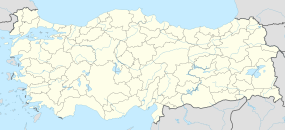Alacahöyük

Alaca Höyük
|
|
| Location | Çorum Province, Turkey |
|---|---|
| Region | Anatolia |
| Coordinates | 40°14′04″N 34°41′44″E / 40.23444°N 34.69556°ECoordinates: 40°14′04″N 34°41′44″E / 40.23444°N 34.69556°E |
| Type | Settlement |
| Site notes | |
| Condition | In ruins |
Alacahöyük or Alaca Höyük (sometimes also spelled as Alacahüyük, Aladja-Hoyuk, Euyuk, or Evuk) is the site of a Neolithic and Hittite settlement and is an important archaeological site. It is situated in Alaca, Çorum Province, Turkey, northeast of Boğazkale (formerly and more familiarly Boğazköy), where the ancient capital city Hattusa of the Hittite Empire was situated. Its Hittite name is unknown: connections with Arinna, Tawiniya, and Zippalanda have all been suggested.
The mound (Turkish höyük) at Alacahöyük was a scene of settlement in a continuous sequence of development from the Chalcolithic Age, when earliest copper tools appeared alongside the use of stone tools. During the Early Bronze Age, the mound was the center of a flourishing Hattian culture. It has been continuously occupied ever since, until today's modern settlement in the form of a small village. The standing and distinguishing remains at Alacahöyük, however, such as the "Sphinx Gate", date from the Hittite period that followed the Hatti, from the fourteenth century BC.
Thirteen shaft-grave "Royal Tombs" (EBII, ca. 2350-2150 BC) in Alacahöyük contained the dead in fetal position facing south. They were richly adorned with gold fibulae, diadems, and belt buckles and repoussé gold-leaf figures.
According to Trevor Bryce,
...
Wikipedia

